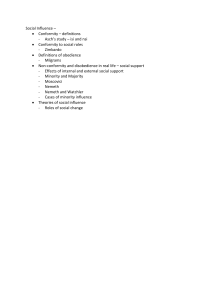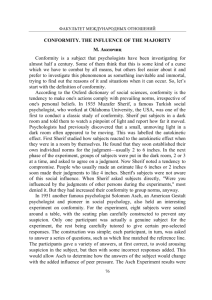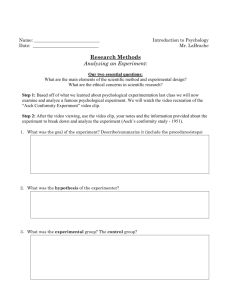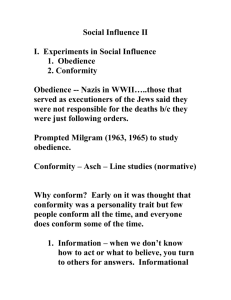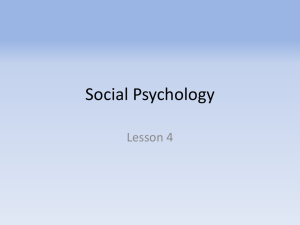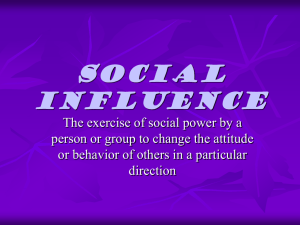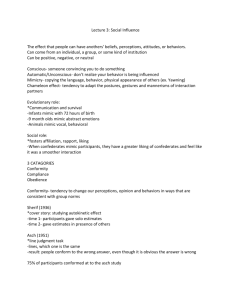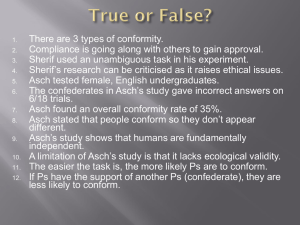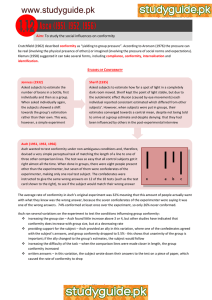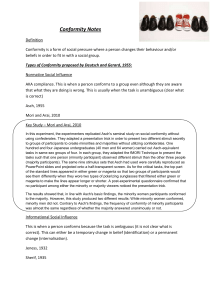Introduction & Theoretical Perspectives
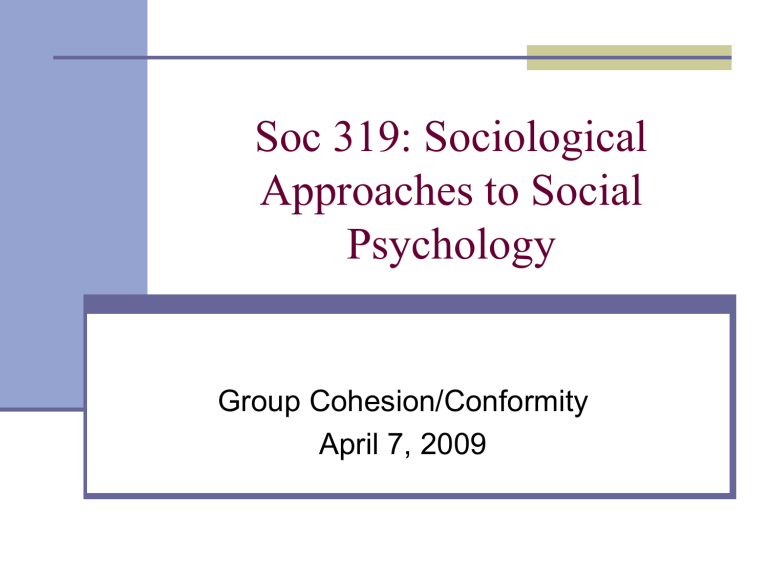
Soc 319: Sociological
Approaches to Social
Psychology
Group Cohesion/Conformity
April 7, 2009
Group Cohesion and Conformity
A. What is a group?
A social unit with two or more persons, and which has:
Common goals : members share at least one common goal to be achieved through joint action .
Interaction : members communicate with and influence one another.
Normative expectations : members share a set of expectations about group norms and members’ roles.
Identification : members consciously identify with the group and think of themselves as members.
Examples of non-groups vs. groups
Is not a group
Is a group
B. Majority Influence and Conformity
Conformity: Adherence by an individual to group norms. Involves a change in behavior or beliefs as a result of real or imagined group pressure. Not universal!
Informational influence : Sherif (1936) autokinetic effect study
Normative influence : Asch (1952) and replications (e.g., Bond & Smith, 1996)
Sherif autokinetic effect study
http://www.youtube.com/watch?v=DKivdMAgdeA
Asch Conformity
35
30
25
% of Erroneous
20
Responses 15
10
5
0
Control Unanimous Majority
Condition
C. Under What Conditions Do People
Conform?
Size of majority (+)
Unanimity (+)
Value/admire group (+)
Commitment to longterm interaction (+)
Culture of collectivism
(+)
Confident in expertise on issue (-)
Social status (-) *
Strongly committed to their initial view (-)
Do not like or respect source of influence (-)
Culture of individualism
(-) http://www.youtube.com/watch?v=DQ_nM5NkQzs&feature=related
Conformity and Support
%
Erroneous
20 responses 15
10
5
0
35
30
25 control Unanimous
Group
Condition
Single
Supporter
D. How do groups react to dissenters?
1. Group efforts to manage “deviants”
Apply pressure to make “deviant” conform
Persuasion threats punishments
Reject the deviant from the group.
Expel from group
Status degradation
Psychological isolation
D. How do groups react to dissenters?
(cont’d)
2. Minority fights back!
“Active minority” might try to persuade majority group members to accept their viewpoint and adopt a new position (Moscovici, 1980).
Influence of minority contingent upon:
Size . >1 person.
Consistency.
Implies that the minority has a wellarticulated and thoughtful position.
Flexible negotiation style . Rigid negotiation style suggests that minority is inflexible and dogmatic.
Similarity of identity (recall P-O-X model)
E. Groupthink
1. Definition. A mode of thinking and decision-making by group members where pressures for unanimity and cohesiveness overwhelm the group members’ motivation to appraise realistically the alternative courses of action (Janis 1972). “Illusion of consensus”
2. Examples: a. Cuban missile crisis b. Challenger disaster
3. Characteristics
4. Possible solutions
A. Intergroup Conflict: Actual conflict
1. Definition: conflict is the result of direct competition over resources
a. Historical data
b. Experimental data
i. Sherif Robber’s Cave study.
B. How do groups differentiate themselves from one another?
1. Minimal group
a. Tajfel studies
No social interaction between groups
No shared goals
Participants unaware of others’ group membership
2. Social identity theory
a. Studies of ethnic identity and language
(e.g., Brown, 1988)
